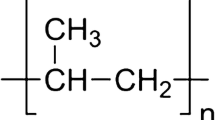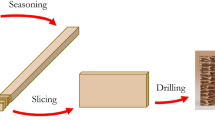Abstract
Temperature-modulated differential scanning calorimetry has been employed to analyze the structure-related thermal properties of petroleum bitumen. This method enables one to distinguish between “order–disorder” and glass transitions, thereby making it possible to monitor and identify structure-related phase transformations, the signals from which are invisible or overlapped in the thermograms of conventional differential scanning calorimetry. Bitumen has been shown to be a colloidal disperse system only under certain temperature–time conditions. Its dispersed phase may be represented by aggregates of two types with colloidal sizes. Saturated hydrocarbons form a solid crystalline phase in accordance with the regularities of first-order structural phase transitions and nucleation mechanism of phase separation. Asphaltenes and resins form a solid amorphous phase for a relatively long time as a result of a structural relaxation glass transition by the spinodal mechanism of phase separation.
Similar content being viewed by others
References
Lesueur, D., Adv. Colloid Interface Sci., 2009, vol. 145, p. 42.
Loeber, L., Muller, G., Morel, J., and Sutton, O., Fuel, 1998, vol. 77, p. 1443.
Polacco, G., Filippi, S., Merusi, F., and Stastna, G., Adv. Colloid Interface Sci., 2015, vol. 224, p. 72.
Redelius, P., Road Mater. Pavement Des., 2009, vol. 10, p. 25.
Wunderlich, B., Boiler, A., Okazaki, I., Ishikiyama, K., Chen, W., Pak, J., Moon, I., and Androsch, R., Thermochim. Acta, 1999, vol. 330, p. 21.
ASTM D4124-09. Standard Test Method for Separation of Asphalt into Four Fractions, Annual Book of Standards, West Conshohocken ASTM International, 2009.
Masson, J.F. and Polomark, G.M., Thermochim. Acta, 2001, vol. 374, p. 105.
Kaplan, D.S., J. Appl. Polym. Sci., 1976, vol. 20, p. 2615.
Hourston, D.Y., Song, M., Schafer, F.U., Pollock, H.M., and Hammiche, A., Thermochim. Acta, 1998, vol. 324, p. 109.
Masson, J.F., Polomark, G.M., and Collin, P., Energy Fuels, 2002, vol. 16, p. 470.
Dorset, D.L., Energy Fuels, 2000, vol. 14, p. 685.
Pechenyi, B.G., Bitumy i bitumnye kompozitsii (Bitumen and Bitumen Compositions), Moscow Khimiya, 1990.
Lipatov, Yu.S., Kolloidnaya khimiya polimerov (Colloid Chemistry of Polymers), Kiev Naukova Dumka, 1984.
Author information
Authors and Affiliations
Corresponding author
Additional information
Original Russian Text © I.N. Frolov, T.N. Yusupova, M.A. Ziganshin, E.S. Okhotnikova, A.A. Firsin, 2016, published in Kolloidnyi Zhurnal, 2016, Vol. 78, No. 5, pp. 650–654.
Rights and permissions
About this article
Cite this article
Frolov, I.N., Yusupova, T.N., Ziganshin, M.A. et al. Features of colloidal disperse structure formation in petroleum bitumen. Colloid J 78, 712–716 (2016). https://doi.org/10.1134/S1061933X16050069
Received:
Published:
Issue Date:
DOI: https://doi.org/10.1134/S1061933X16050069




